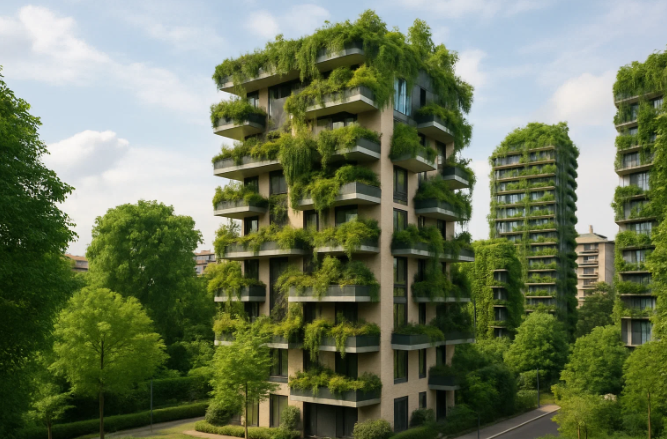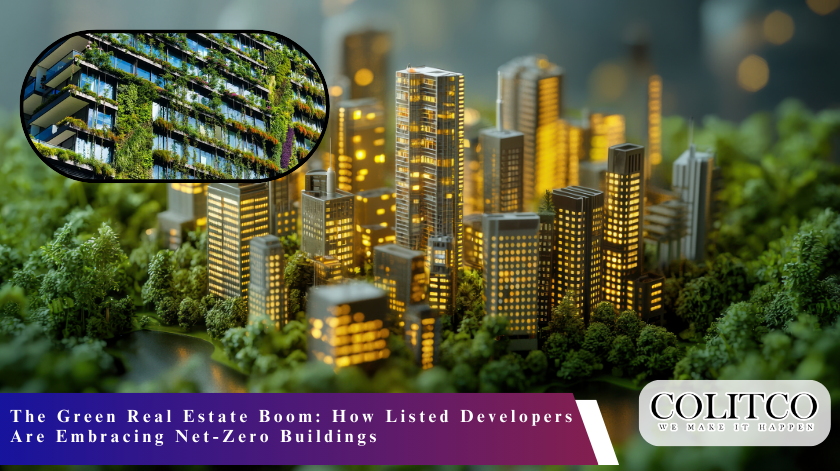The global real estate sector stands at a turning point. Buildings consume approximately 34% of global energy-related CO₂ emissions, making them prime targets for decarbonisation efforts. Listed developers across major exchanges are responding with unprecedented commitments to net-zero buildings – structures that produce as much renewable energy as they consume annually.
This transformation extends far beyond environmental responsibility. Sustainable REITs and green real estate stocks are attracting substantial capital flows as investors increasingly prioritise environmental, social, and governance (ESG) criteria. The shift represents a fundamental reimagining of how commercial and residential properties generate value.

Green Real Estate Boom
Market Forces Driving the Green Revolution
The net-zero buildings market has experienced explosive growth. Industry data shows the sector was valued at $46.6 billion in 2023, with projections reaching $141.8 billion by 2030. This represents a compound annual growth rate of 17.2%.
Several factors fuel this expansion:
- Regulatory Pressure: Governments worldwide are tightening building standards. Australia’s National Construction Code will include embodied carbon standards by 2028. Canada’s Green Buildings Strategy targets 3.5 million new homes by 2030 with accelerated retrofits.
- Investor Demand: ESG-focused investment funds control trillions in assets. Research indicates 81% of investors prioritise environmental sustainability when making allocation decisions.
- Operating Cost Benefits: Net-zero buildings deliver significant operational savings. Heat pump technology can reduce heating emissions by 75-90% by 2050, while buildings with renewable energy systems save £20,000-50,000 over 15 years.
- Tenant Preferences: Corporate tenants increasingly demand sustainable office spaces to meet their own ESG commitments. Properties with green certifications command premium rents and experience lower vacancy rates.
Leading Exchanges Embrace Sustainability
NYSE Champions
Prologis (NYSE: PLD) leads the logistics sector’s sustainability charge. The company targets net-zero operations by 2030 and across its value chain by 2040. Prologis focuses on renewable energy integration across its 5,200 properties spanning 19 countries.
AvalonBay Communities (NYSE: AVB) has earned recognition on Forbes’ 2025 Net Zero Leaders list for the third consecutive year. The multifamily REIT targets a 53% reduction in Scope 1 and 2 greenhouse gas emissions, implementing comprehensive retrofit programmes across its portfolio.
TSX Innovators
Choice Properties REIT (TSX: CHP.UN) operates Canada’s largest retail property portfolio with Science Based Targets initiative (SBTi) validated commitments. The company’s Pathway to Net Zero report outlines net-zero goals by 2050, with 50% reductions in Scope 1 and 2 emissions by 2030.
Dream Group (TSX: DRM) integrates impact investing principles across its mixed-use developments. The company targets net-zero by 2035 through comprehensive sustainability strategies spanning residential, commercial, and industrial assets.
ASX Leaders
Goodman Group (ASX: GMG) achieved carbon-neutral operations and commits to 100% renewable energy by 2030. The industrial property giant focuses on solar installations and energy-efficient warehouse designs across its global portfolio.
Mirvac (ASX: MGR) targets net-positive carbon by 2030. The company’s projects like Heritage Lanes operate as net-zero buildings, featuring renewable electricity integration and passive design principles. Mirvac’s certified buildings demonstrate 62% lower emissions compared to conventional structures.
Technology Innovations Powering Green Buildings
The transition to net-zero buildings relies on sophisticated technological integration. Modern developments combine multiple systems to achieve carbon neutrality while maintaining occupant comfort and operational efficiency.
Heat Pump Revolution
Heat pumps represent a cornerstone technology for eco-friendly property development. These systems operate at 300-500% efficiency, dramatically outperforming traditional heating methods. Air-to-water heat pumps cost approximately $7,000 upfront but deliver 60-70% reductions in energy bills.
The Energy Transitions Commission reports that widespread heat pump adoption could cut heating emissions by 75-90% by 2050. This technology enables buildings to eliminate fossil fuel dependency while reducing operational carbon footprints.
Solar Integration and Energy Storage
Photovoltaic systems form the backbone of most net-zero buildings. Solar panel costs have dropped significantly, with installations ranging from $100-150 per kilowatt. Combined with battery storage systems, buildings can achieve energy independence while feeding excess generation back to the grid.
Sustainable REITs are installing solar across existing portfolios. Goodman Group has deployed solar systems across 375 properties, generating over 200MW of renewable capacity. This approach transforms buildings from energy consumers into energy producers.
Smart Building Systems
Advanced building management systems optimise energy consumption in real-time. These platforms integrate:
- Automated lighting controls reducing consumption by 20-30%
- HVAC systems that adjust based on occupancy and weather conditions
- Energy monitoring providing granular usage data
- Predictive maintenance reducing equipment inefficiencies
Green real estate stocks investing in smart technologies report improved net operating income margins as systems reduce both energy costs and maintenance requirements.
Cost-Benefit Analysis: The Financial Case
The economics of net-zero buildings have shifted dramatically in developers’ favour. While construction premiums exist, operational savings and asset value appreciation create compelling investment propositions.
Construction Cost Premiums
Net-zero buildings typically require 1-5% additional construction investment compared to conventional buildings. However, costs continue declining as technologies mature and supply chains develop.
Passive design principles can reduce energy requirements by 15-30% with minimal cost impact. High-performance building envelopes, optimised orientations, and natural ventilation systems achieve significant efficiency gains without substantial premium.
Operational Savings
The financial benefits become apparent during operations:
Energy Cost Reductions: Buildings with renewable energy systems eliminate grid electricity purchases. Some developments achieve “zero bills” status, saving £20,000-50,000 over 15 years per residential unit.
Maintenance Efficiency: Modern building systems require less maintenance than legacy equipment. Heat pumps have 20-year lifespans with minimal service requirements, reducing ongoing operational expenses.
Carbon Pricing: As carbon pricing mechanisms expand globally, net-zero buildings avoid future carbon taxes and benefit from potential carbon credit revenues.
Premium Asset Values
Sustainable REITs report higher valuations for green-certified properties. Research indicates buildings with sustainability certifications achieve:
- 10-15% rental premiums in major markets
- Lower vacancy rates due to tenant preferences
- Extended asset lifecycles through future-proofed systems
- Access to green financing at preferential rates
Also Read: Victory Metals Limited: A Critical Minerals Player Shaping Australia’s Rare Earth Supply Chain
Case Study Deep Dive: Lendlease’s Sustainability Leadership
Lendlease (ASX: LLC) exemplifies how major developers integrate sustainability across operations. The company targets net-zero carbon by 2025 for operations and 2040 across its value chain.

Barangaroo South Project
Lendlease’s Barangaroo South development in Sydney demonstrates net-zero buildings at scale. The precinct features:
- 100% renewable electricity through on-site generation and green energy procurement
- Advanced waste heat recovery systems
- Integrated stormwater management reducing water consumption by 50%
- NABERS 6-star energy ratings across commercial buildings
The project achieved carbon neutrality ahead of schedule while commanding premium lease rates. Major tenants including international banks and technology companies cite sustainability credentials as key location factors.
Build-to-Rent Developments
Lendlease’s residential developments increasingly target net-zero buildings status. The company’s build-to-rent projects feature:
- All-electric systems eliminating gas connections
- Solar panels with battery storage on residential buildings
- Shared mobility solutions reducing transport emissions
- Green roofs and facades improving biodiversity
These developments attract environmentally conscious tenants willing to pay premiums for sustainable living options.
International Success Stories
Brookfield’s Global Portfolio
Brookfield (NYSE: BAM, TSX: BAM.A) manages one of the world’s largest real estate portfolios with comprehensive sustainability commitments. The company targets net-zero emissions by 2050 across its global operations.

Brookfield Asset Management Ltd.
Brookfield’s approach includes:
Retrofit Programmes: Systematic upgrades across existing properties installing energy-efficient systems, LED lighting, and smart building controls.
New Development Standards: All new construction must achieve green building certifications with pathways to net-zero buildings status.
Renewable Energy: Over 20GW of renewable energy generation capacity supporting both operations and third-party sales.
British Land’s London Leadership
British Land (LSE: BLND) leads the UK commercial property sector’s sustainability efforts. The company achieved net-zero carbon for operations in 2020 and targets value chain neutrality by 2030.

The British Land Company Public Limited Company
Key initiatives include:
- Refurbishment projects achieving BREEAM Outstanding ratings
- On-site renewable energy generation across office and retail properties
- Electric vehicle charging infrastructure supporting tenant transition
- Embodied carbon reduction through material selection and circular economy principles
British Land’s Canada Water development showcases net-zero buildings in mixed-use urban regeneration, combining residential, office, and retail spaces with integrated sustainability systems.
ESG Investment Surge
Green real estate stocks benefit from massive capital flows into ESG-focused investment strategies. Global ESG assets under management reached $35 trillion in 2020, with real estate commanding significant allocations.
Institutional Investor Preferences
Pension funds, sovereign wealth funds, and insurance companies increasingly mandate sustainability criteria. The Canada Pension Plan Investment Board targets net-zero portfolio emissions by 2050, driving investment toward sustainable REITs and green property companies.
Major institutional investors report that sustainability metrics influence:
- Asset allocation decisions
- Due diligence processes
- Portfolio construction strategies
- Long-term return expectations
Green Finance Products
Financial markets have responded with innovative products supporting eco-friendly property development:
- Green Bonds: Real estate companies issued $149 billion in green bonds in 2021, financing sustainability projects and net-zero buildings.
- Sustainability-Linked Loans: Interest rates tied to ESG performance metrics incentivise developers to achieve sustainability targets.
- Green REITs: Specialised funds focusing exclusively on sustainable property investments attract dedicated capital flows.
Market Outlook and Future Projections
The net-zero buildings sector shows no signs of slowing. Multiple forecasts indicate accelerating growth driven by policy support, technology advancement, and investor demand convergence.
Global Growth Projections
Market research firms project the global net-zero buildings market could reach $416.6 billion by 2030 under aggressive adoption scenarios. This represents nearly ten-fold growth from current levels.
Regional growth patterns vary significantly:
- Asia-Pacific: Expected to witness the fastest expansion, with China and India driving demand through urbanisation and policy mandates. The region could account for 40% of global net-zero buildings construction by 2030.
- Europe: Leading in regulatory frameworks with the EU’s Green Deal requiring major emissions reductions. European sustainable REITs benefit from supportive policy environments and established green finance markets.
- North America: Strong growth driven by federal incentives and state-level mandates. The Inflation Reduction Act provides $8.8 billion in building efficiency rebates, accelerating adoption across residential and commercial sectors.
Technology Cost Trajectories
Critical technology costs continue declining, improving net-zero buildings economics:
- Heat Pump Costs: Expected to fall 20-30% by 2030 as manufacturing scales and supply chains mature.
- Solar PV Systems: Costs dropped 85% between 2010-2020 and continue declining at 7-10% annually.
- Battery Storage: Lithium-ion battery costs fell 89% between 2010-2020, with further reductions anticipated as electric vehicle adoption drives scale.
- Building Materials: Sustainable materials like cross-laminated timber achieve cost parity with conventional alternatives in many regions.
Challenges and Implementation Barriers
Despite promising outlook, eco-friendly property development faces several obstacles requiring industry-wide solutions.
Upfront Capital Requirements
Net-zero buildings require higher initial investment, creating financing challenges particularly for smaller developers. Construction loans often fail to account for operational savings, making projects appear less viable under traditional underwriting criteria.
Green real estate stocks with strong balance sheets hold advantages in accessing capital for sustainability initiatives. Companies like Goodman Group and Mirvac leverage established relationships with green-focused lenders to finance portfolio transitions.
Skills and Supply Chain Constraints
The construction industry lacks sufficient skilled workers familiar with net-zero buildings technologies. Heat pump installations, smart building systems, and renewable energy integration require specialised expertise currently in short supply.
Supply chain bottlenecks affect critical components:
- Heat pump manufacturing capacity constraints
- Solar panel supply chain dependencies
- Battery storage component shortages
- Sustainable building material availability
Retrofitting Existing Stock
New construction represents only 1-3% annual addition to building stock. Achieving sector-wide decarbonisation requires retrofitting existing buildings to net-zero buildings standards.
Retrofit challenges include:
- Technical Complexity: Older buildings may require substantial structural modifications to accommodate modern systems.
- Tenant Disruption: Major retrofits can displace tenants, creating revenue interruptions for sustainable REITs.
- Split Incentives: Property owners invest in upgrades while tenants receive operational benefits, creating misaligned incentives.
- Heritage Constraints: Historic buildings face preservation requirements limiting retrofit options.
Regional Policy Landscapes
Government policies significantly influence net-zero buildings adoption rates across different markets.
Australia’s Leadership Position
Australia leads global sustainability rankings with comprehensive policy frameworks. The Clean Energy Finance Corporation provides $10 billion in green investment capacity, supporting sustainable REITs and property developers.
Key Australian initiatives include:
- National Construction Code updates requiring disclosure of embodied carbon
- State-based renewable energy targets driving demand
- Green building certification programmes with financial incentives
- Research and development funding for building technology innovation
Canada’s Integrated Approach
Canada’s federal government coordinates with provinces on building decarbonisation through the Pan-Canadian Framework on Clean Growth. The strategy includes:
- National zero-carbon building standards
- Retrofit accelerator programmes
- Indigenous housing sustainability initiatives
- Green building skills training programmes
Sustainable REITs on the TSX benefit from supportive policy environments and access to government financing programmes.
United States Federal Support
The Inflation Reduction Act represents the largest climate investment in US history, providing substantial support for net-zero buildings:
- $9 billion in home energy rebates
- Tax credits for heat pump installations
- Commercial building efficiency tax deductions
- Green bond financing support
These incentives improve project economics for green real estate stocks operating in the US market.
Innovation Pipeline and Future Technologies
The net-zero buildings sector continues evolving with emerging technologies promising further performance improvements and cost reductions.
Advanced Building Materials
Next-generation materials offer superior performance with lower environmental impact:
Bio-based Materials: Mycelium insulation, hemp-based composites, and algae-derived materials provide sustainable alternatives to conventional building products.
Phase Change Materials: Thermal storage systems using phase change materials reduce heating and cooling energy requirements by 30-50%.
Smart Glass: Electrochromic windows adjust transparency based on sunlight conditions, reducing cooling loads while maintaining natural lighting.
Artificial Intelligence Integration
AI systems optimise building performance through:
- Predictive maintenance reducing equipment downtime
- Occupancy-based system control minimising energy waste
- Grid integration optimising renewable energy usage
- Performance benchmarking identifying improvement opportunities
Sustainable REITs investing in AI-enabled building management report 10-15% additional energy savings beyond conventional systems.
District-Scale Solutions
Future developments increasingly adopt district-scale approaches to net-zero buildings:
Micro-grids: Local energy networks enabling buildings to share renewable generation and storage capacity.
District Heating/Cooling: Centralised systems serving multiple buildings more efficiently than individual systems.
Shared Infrastructure: Common facilities like electric vehicle charging, energy storage, and waste management reducing per-building costs.
Also Read: Victory Metals Limited: A Critical Minerals Player Shaping Australia’s Rare Earth Supply Chain
Investment Strategies and Portfolio Construction
Investors seeking exposure to green real estate stocks have multiple approaches for building sustainable property portfolios.
Direct REIT Investment
Sustainable REITs offer targeted exposure to companies leading the net-zero buildings transition. Key selection criteria include:
- Science-based emissions reduction targets
- Green building certification percentages
- Renewable energy generation capacity
- ESG reporting transparency and third-party verification
Thematic ETFs
Exchange-traded funds focusing on sustainable real estate provide diversified exposure across regions and property types. Popular funds include holdings in companies like Lendlease, Brookfield, and other green real estate stocks.
Infrastructure Integration
Real estate investment increasingly intersects with renewable energy infrastructure. Sustainable REITs developing on-site generation create value through:
- Reduced operational costs
- Revenue from excess energy sales
- Energy storage arbitrage opportunities
- Grid services providing additional income streams
Long-Term Value Creation
Net-zero buildings represent more than environmental compliance—they constitute a fundamental shift toward resilient, future-proofed assets commanding premium valuations.
Asset Quality and Longevity
Buildings designed for net-zero building performance typically feature:
- High-quality construction materials and systems
- Advanced building envelopes reducing maintenance requirements
- Flexible infrastructure accommodating future technology upgrades
- Resilient design principles addressing climate change impacts
These characteristics extend asset lifecycles and reduce lifecycle costs, supporting higher property valuations.
Tenant Attraction and Retention
Corporate tenants increasingly prioritise sustainable office space to meet stakeholder expectations and regulatory requirements. Green real estate stocks benefit from:
- Lower vacancy rates in sustainable properties
- Longer lease terms from committed tenants
- Premium rents justified by operational cost savings
- Reduced tenant improvement costs in high-performance spaces
Future-Proofing Against Regulation
Net-zero buildings provide insurance against future regulatory requirements. As governments implement stricter building performance standards, sustainable properties maintain compliance while conventional buildings require costly upgrades.
Conclusion
The green real estate boom represents a permanent shift in how the industry creates, operates, and values buildings. Listed developers embracing net-zero buildings position themselves advantageously in markets increasingly prioritising sustainability alongside financial returns.
Sustainable REITs and green real estate stocks benefit from multiple converging trends: regulatory mandates, investor preferences, tenant demand, and improving technology economics. Companies like Lendlease, Goodman Group, Mirvac, Brookfield, and British Land demonstrate that sustainability leadership translates into operational excellence and financial outperformance.
The transition requires significant upfront investment and operational changes. However, early movers gain competitive advantages through:
- Access to ESG-focused capital at preferential terms
- Premium asset valuations reflecting future-proofed characteristics
- Operational cost advantages from energy-efficient systems
- Tenant preference for high-performance, sustainable buildings
Net-zero buildings will become the standard rather than the exception. Property companies embracing this transition today position themselves as tomorrow’s industry leaders, capturing value from the intersection of environmental responsibility and financial performance.
For investors seeking exposure to this transformation, sustainable REITs and eco-friendly property development companies offer compelling opportunities to participate in the green real estate boom while supporting the global transition to a sustainable built environment.
The future of real estate is sustainable, efficient, and resilient. Companies leading this transformation will define the industry’s next chapter while delivering superior returns to stakeholders committed to long-term value creation.












